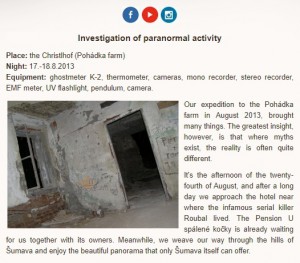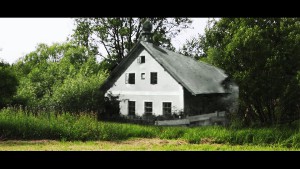Case No. 22 | Christlhof Farm - Pohádka Farm (2019)
Few places were as important to our association as the famous Pohádka farm. It was here that we conducted our third research in 2013. And there we tested that purely objective procedures are the way to go.
It was a time when our association consisted of only two members: Ondřej Bezouška and Aima Mindlová. And the Paranormal tým itself did not yet have its typical circular logo and clear methodology of work.The methodology of work was between esotericism and more skeptical investigation. You might be surprised, but these were some of the freest investigations because we weren't shackled by reality. We used the instruments beyond their recommendations. They abstractly conjectured the responses of the meters, creating the wildest stories of what might have happened at such and such a place.
The Pohádka Farm was new to us in that for the first time ever we approached research objectively. From the locals we obtained a lot of information about Roubal and the Pangerls. And then we published all these bits and pieces in a lengthy article. But the video was never made. I knew even then that I would return to the Pohádka Farm and correct my rest for this reason. And I also knew that it would be a great documentary that would go beyond late night investigations and offer people clear answers.
Now let's make the cut to 2019. In this last healthy year before the world descended into pandemonium, our team returned to this farm. Years of experience, with a clear methodology, goal and technique.
Research members from 12-13 July 2019:
For the Paranormal tým z.s.
Michala Valešková - Head of Research and Security
Ondřej Bezouška - documentary filmmaker
Kamil Valeška - technician
Pavel Mička - investigator
Non-party observers:
Jan Jelinek
Petr Sousedík
We found the Pohádka farmhouse in a similar condition as in 2013. The only thing that had disappeared were the power poles, which the owners of the land had had torn down so that they could cultivate the surrounding fields without restrictions. That's also the only thing anyone cares about here.
The walls of the fairy tale were covered with a new layer of inscriptions and engravings. A number of people are immortalized here as if they've conquered Mount Everest. The interiors are bare, but pieces of bedding and old furniture are strewn about.
We make our base in the pigsty. Misha goes through the building and warns everyone about the dangerous places where it is forbidden to enter.
Ondřej Bezouška has found a place in the field that is significantly cooler than the ambient air (about 5°C). This is not a paranormal phenomenon, but a rational one. The local soil is saturated with water. And its temperature in some places cools the nearby air noticeably.
Ondřej next finds the first negative report. A strong storm is approaching Šumava from Plzeň. And the Christlhof farm is due to be hit at around 10 p.m., just as the first phase of the investigation is about to begin. That's why we have to rethink the whole concept of our research.
In normal terms, our paranormal investigation has three successive phases (we call them the 3I):
Phase 1 Informative - we find out the common values in the studied area. How electromagnetism, temperature, wind behave here. Just the normal state of things here.
Phase 2 Interventional - our research attempts to deviate the values measured in the first phase, abnormally.
Phase 3 Isolation - we test the psychological element of the research, i.e. the individual - the subject alone. In essence, this is a reconstruction of the conditions under which someone experienced something.
FIRST PHASE OF THE INVESTIGATION
Normally, the first phase of the investigation is informative. This is also true this time, except that we are incorporating the intervention phase, because the storm will fundamentally change the conditions of the research.
During this time, an impartial observer, Jan Jelinek, notes that in the so-called empty room (as Ivan Roubal called it in his note), his electromagnetism measuring device jumped to red values. Unfortunately, this abnormality is not supported by camera footage and, moreover, has not been repeated. Thus we cannot confirm it with valid data.
According to the measurements in this part of the research, the entire Christlhof before and during the storm did not show any strange values that would have caught our attention. In MilliGauss, the farmhouse is at a value of around one, which does not pose any risk or health problem.
In addition, the electronics are running as they should and we have no complications with them.
Why do I mention electronics? Because it's one of the things that's supposed to have a high failure rate here. I remember a Česká televize (Czech TV) show on mysteries and mystery where in an episode about the Christlhof, a cameraman whose Swiss watch was supposed to have broken.
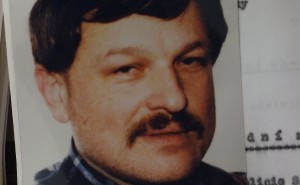
Facts about Roubal
The Christlhof estate would not be so famous if it were not for a convicted serial killer: Ivan Roubal. We wrote about him extensively in an article a few years ago. Even so, we found a lot more information about him.
First of all, let's mention that Ivan Roubal did not buy the Pohádka farm illegally, but rented it. Until then, he led an orderly life. He was not allowed to breed deer, but he made up for it by breeding Vietnamese pigs, horses and chickens.
It is important for the following lines to mention in what state the Pohádka Farm was when Roubal came upon it. Its most glorious years were long gone. The interior had undergone various alterations. The furnace disappeared, the room was divided by a wall for the kitchen and the inner entrance to the barn was walled up. Although the Christlhof had been electrified long ago, the electricity was not working. Roubal solved this complication with a battery from the bus, which he used to take to the blacksmith to recharge, so that the electronics would work for a few days. This kept him connected to the world. He had an old television set, but he used it only minimally and his favourite thing to listen to was the radio.
Each of his mornings began with a kind of ritual, where he would check the level of the outside "smog" (as Roubal himself writes) through the toilet window during the morning's chores, before going on to perform his other duties.
From his hand drawing of the Christlhof (see attachment below) it is astonishing how many beds he had in the Pohádka Farm.One canape, four beds and one double bed. And it is said that he lived alone at the Pohádka Farm. But this is not entirely true. After Václav Havel's general amnesty in 1990, some released prisoners came to help out at Christlhof. This finally links Roubal to the criminal milieu. Moreover, we know that Roubal often left the Pohádka Farm, so someone had to take care of his animals. He considered finding a companion himself, and indeed invited an acquaintance from Russia to join him at the Christlhof. Her name was Natasha and she was promised a wonderful fairy-tale life on the abandoned farm.
But after arriving there, Natasha found that life here is not so fabulous. The Christlhof was already in decay at that time. The vision of a beautiful life had taken its toll. She became estranged from Roubal, but instead found support in František H., a local businessman who owned a sawmill in the Klatovy region. In fact, we could say that he was Roubal's friend.
As soon as Natasha decided to move in with František, all friendly ties on Roubal's part ended. We know from the killer's future actions that he was highly egocentric, even narcissistic. This is what seems to have influenced his next decision. Somewhere near or on Christlhof, he killed them both. The bodies were never found.
During the investigation into their disappearance, Roubal shows the police a supposed letter from František stating that he and Natasha are leaving for Germany permanently. But he operates with František's personal property as if he will never retrieve it. He sells it off, and uses others as his own (such as a car). A pattern of behaviour that he later repeats with his other victims.
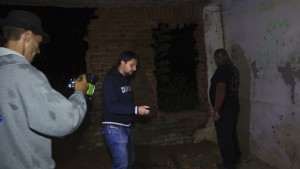
SECOND PHASE OF THE INVESTIGATION
The rain falls through holes in the roof, into the interior of the house. Water drips between the cracks and crevices in the walls. No, Christlhof can't even hold water anymore. Five years and other parts of the house collapse.
What was once a cosy farmhouse is becoming more and more of a ruin.
The holes in the ground that were dug by the police in the 1990s (when they were looking for the bodies of Natasha and František) are filling up with water. The dark night is illuminated by lightning, which after a few seconds is accompanied by thunder. A true Šumava storm.
But the instruments inside the Fairy Tale do not detect any abnormalities in the electromagnetic field. On the contrary, they show the same readings as before the storm. Good news, because lightning doesn't affect their functioning. So the investigation can continue.
We are now focusing on the attic space. It's quiet here, too. Bats flit around our heads and mice that have made this place their home scurry around the floor.
Temperatures are constant. The camera documents all the action without interruption. Our cell phones are off. And at this quiet moment, the K2 EMF meter begins to react to a sudden abnormality in the electromagnetic field. It will rise to over 20 milliGauss and drop back down. All it takes is a few seconds. We're trying to analyse the incident further, but it's so sudden and brief that we can hardly attribute any significant value to it. Nevertheless, it is a curiosity worth noting. We count three such sudden reactions during the night. Our guest Jan Jelinek was present at all of them. Yet, he does not have any device on him that could affect the electromagnetic field so strongly at a distance of half to two meters.
At the same time, we're trying to analyse the audio trace during the investigation. But the storm is having a negative effect on it, because there's nothing to analyse because of the rain and the storm.
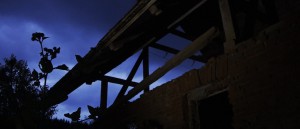
Facts about the witch
It is apt that it is during a storm that we investigate possible paranormal phenomena, because some legends claim that during a similar storm, a mob of guards lynched a local witch. A woman who was supposed to be responsible for the huge fire in Strážov on May 12, 1828.
Legend has it that she was driven to a local old tree where she was stoned to death by the lynch mob. With her last breath, she then uttered a curse, wishing misfortune and death not to the citizens of the burnt town, but to the future owners of this farm. Why? The legend doesn't answer that.
After investigating, our team and I set about a detailed search for any record of the possible reality of this legend. We were interested in three points:
1) Was there really a fire in Strážov in May 1828?
2) If there was a fire, who was responsible for it?
3) Was any particular person lynched during or after the fire?
After communicating with archivists and chroniclers, we gradually pieced together the facts side by side. Facts that are quite different from the traditional legends.
The fire of Strážov really happened on 12 May 1828. We know this thanks to the chronicle and the mention of the volunteer firefighters for whom the event was of historical importance. During the disaster, for the first time ever, local people used a syringe to extinguish the fire (it should be noted that it did not have the desired effect).
So we have a fire. Who's responsible for it? According to the Chronicle, it's really the woman's fault. Teresa Lasner, who belonged to the local Jewish community. The perfect person to lynch.
What actually happened? On the fateful day, in building 45, Terezie Lasner was preparing a meal. She melted butter in a saucepan and left it on the stove. At that moment, a storm was brewing outside. It's possible that it caught her attention and she stopped cooking.
The butter overflowed, the contents in the casserole caught fire. And a shocked Terezie Lasner set about solving the problem in probably the worst possible way. She poured water on the burning butter. There was a massive blaze that started a fire that left two-thirds of the village in ashes. These were very dramatic moments. Children and their mothers were crying in the square, having been forced to leave their dwellings. Among them, panic-stricken cattle ran in panic from the smoke, and exhausted men tried to save at least the most precious things.
With the fire of Strážov any written mention of Terezie Lasner ends. Did she die in the fire? Was she lynched? We didn't want to accept this half-hearted ending. And that's why we kept digging. It wasn't until we got an answer from the Klatovy State District Archives that finally put an end to the legend. The originator of the fire of May 12, 1828, survived the fire. The hatred of her fellow citizens did not catch her. How do we know? Well, because you can still find Terezie Lasner's name in Strážov. More precisely in the Jewish cemetery, where she was buried after she died on August 3, 1856, at the age of 71. Twenty-seven years after the fatal fire. And since she died in Strážov, it is hard to imagine that she would have lived there if she had been hated by the local inhabitants afterwards.
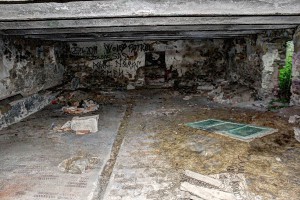
THIRD PHASE OF THE INVESTIGATION
The storm is passing, the rain is not letting up. We leave the individual members of our association in the barn where Ivan Roubal allegedly had the bodies of Natasha and František fed, and we try to see if they experience anything mysterious.
Ondřej Bezouška is the first to go. But he doesn't experience anything paranormal during his half an hour, and even the instruments remain calm.
Jan Jelínek is next. A person who has already experienced the electromagnetic field reaction here several times. And this reaction reappears again during his half hour. Again, an abnormality of a few seconds. Why him? Either because of chance (the reaction would have appeared at that moment no matter who had the device), or because of his emotional state, because Jan Jelinek, of all those present, is most expecting an experience (if we consider that our emotions can be indicated in the electromagnetic spectrum). Or for some other reason unknown to us.
Pavel Mička is the last one in the former pigsty. His half an hour is similar to the one Ondřej Bezouška experienced here. The only difference is that at one point he was frightened by a mouse that ran past him.
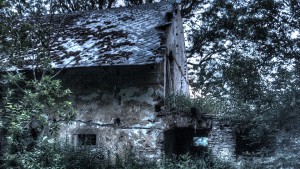
Facts about the Pangerls
Before we conclude the investigation, let's come to the last topic of our research. And that's the Pangerlo family. According to civil records, they lived on the Christlhof farm from 1882. The last generation of this family is said to have gone mad, committed suicide and murder in this place.
However, according to the surviving records, the reality is different.
Karl and Barbara Pangerl had a total of eight children. Six sons and two daughters. They lived a hard but happy life at Pohádka Farm. The Bohemian Forest gives nothing for nothing. The memories of this family are fond. Karl Pangerl spoke both German and Czech and was popular among the locals. This did not change even after the entire border region was occupied by Nazi Germany after the Munich Agreement in 1938.
According to surviving records, Karl Pangerl did not cooperate with the Nazis in any significant way. Of course, he was German. And as such, he had to provide his sons to the Reich.
His eldest son, Karl the Younger, dies at the front. His brother Sepl is seriously wounded in battle, but survives. The next man to be deployed to the war is captured by the Americans.
The last two sons, Vili and Vencl, were not deployed at all. This is because Vili was about five years old and Vencl was even a baby. This allowed them to stay at home with their sisters Maria and Karolina.
Perhaps the most moving fate of this family was the youngest of the sons deployed: Luis. He was sixteen years old when he was drafted into the war. It was the end of it. He served as a private at Luftschutz. However, he never saw combat. In 1945, while returning home with Wenzel Denke, he was ambushed by self-styled Čachrov Red Guard partisans a short distance from the Christlhof itself. They shot him on the spot.
To make the bad news worse, after the war came the forced removal of the border Germans. It was this that directly affected the Pangerl family. So not an escape from a haunted farm, but a state-forced departure. The whole family then survived just over the German border. They never returned to Christlhof.
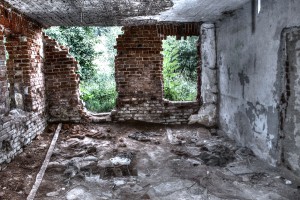
CONCLUSION
The analyses of the Christlhof investigation have been ongoing for a whole year. The search for archives and chronicles took a similarly long time. This article is composed of their contents.
In conclusion, we must say that Christlhof is a homestead with a turbulent history in a fabulous natural setting.
Unfortunately, all it took was one serial killer for all real history to be forgotten and replaced by rumors and myths. In this article, we have tried to piece that ancient reality back together and present it to you in the most compelling way possible.
If you have come this far in your reading, I believe we have succeeded. And I will be very glad if you think of Christlhof not as a haunted place, but as a historical place. For that is what it is, with its centuries of history.
The walls of the Pohádka Farm may not be standing for hundreds of years. But the stories about it will endure. So make them as real as possible, and as mythical as possible.
Author of the article: Ondřej Bezouška
ANNEX TO ARTICLE 1
- FULL TRANSCRIPT OF THE STRÁŽOV CHRONICLE OF THE FIRE OF 12 MAY 1828 -
Sent by Mr. Mayor J. Rousek
Fire in 1828.
A fire of catastrophic proportions struck the town of Strážov on 12 May 1828. According to the reports of the witnesses, the fire started behind the building no. 45 /now: Jakub Kalivoda/, which belonged to a Jew Josef Lasner, vulgo Jouzl. His wife, Terezie, overcooked butter on the stove and it caught fire. Soon the whole wooden building was in flames. Unfortunately, the fire spread rapidly in all directions. All the buildings in the town, except the town hall and the school, were made of wood. And so almost 2/3 of Strážov fell victim to the fire.
The whole of the former New Town Upper, the original Jewish Quarter, the street to Rovná, the west and north side of Upper Square, the street to Lukavica, the east side of the square, the farmsteads from the town hall to No. 79 /at the Poubrlík family's/ with the exception of Nos. 73, 74, 75 and 76 were burned. In Hradčany, 3 buildings burnt down: No. 133 /by the Bulks/, No. 7 /by the Schůdeks/ and No. 8 /by the Kašů/.
The fire destroyed the following houses and farmsteads with outbuildings: no. 43, 44, 130, 45, 46, 47, 48, 50, 51, 52, 54, - 37, 38, 39, 40, 41, 42, Jewish houses no. I.-X., XII.-XVI. At Hradčany, nos. 133, 7, 8. At the square, nos. 1, 2, 3, 4, 55, 57, 58, 59. In the street to Lukavica, Nos. 60, 61, 62, 63, 64, 65. On the east side of the square Nos. 66, 67, 68, 69, 70, 71. From the town hall to the south Nos. 72, 73, 129, 78, 79. Then Nos. 135, 139 and 144. In the area engulfed in flames, Nos. 36, 49, 53 and 138 escaped destruction.
The upper square was burning on three sides throughout the night. In the sea of flames and clouds of smoke there were strange cattle running around, children screaming desperately in cradles brought out of the burning buildings into the square. That day was called "judgment day" by the people.
The town hall from 1806, which no one defended, burned down in this great fire. Almost all the records and monuments with the old town archives fell victim to the raging flames, to irreparable damage. Everyone defended only his own property against the fire. Only the municipal elder Václav Holub from No. 60, although his own homestead was in ashes, entered the burning town hall with his own life, threw the municipal cash box through the window, which contained bonds and cash of 803 zloty. W.W. For this heroic deed he was rewarded with 20 zl. C M /silver/ from the municipal treasury.
During the fire, the population used hand-held sprinklers and one four-wheeled wagon sprinkler without hoses, purchased in 1826. However, the fight with the fire was lost.
On the very next day after the terrible fire, 13 May 1828, the regional authority in Klatovy issued in its circular No. 4186 a German appeal for help for the burnt victims, which read as follows:
According to a report received from the Bystřice authorities, the local protection town was destroyed by a devastating fire yesterday. The fire broke out in an as yet unidentified manner in the evening of yesterday and spread in the prevailing strong wind so that in less than three hours the whole town, with the exception of a few houses, was in flames and was also consumed by them.
The burnt people of this town, deprived of all necessities, are in a deplorable situation, since, owing to the rapid spread of the fire, they could only remember to save their bare lives, and had to leave everything to the rapacious element.
A disaster of this magnitude, which has impoverished so many families at once, requires the most immediate assistance!!
In full confidence in the general participation in this great fire disaster, the regional authority hastens to make known to all the heads of the authorities the most urgent appeal for the present moment, when the afflicted lack all the necessities of life, to collect money or necessities of life with the greatest haste and to send these support contributions to the Bystřice protective superior authority as soon as possible, which will make the last contribution in agreement with the Strážov rapid authority.
Lists of the charity received shall be sent here.
The circular shall be sent from village to village as quickly as possible.
Kiwisch.
Three families were robbed in the fire. Paleček, a yeoman of No. 6, Josef Škach of No. 77 and Josef Tomás of No. 42 /from a canvas/.
The burnt houses were rebuilt this time of stone and brick with a shingle roof. Only the house no. 51 in the street to the flat of the tailor Ondřej Tendler was not rebuilt and the town hall of Strážov waited like a burning place for its resurrection for 30 years!
The amount of charity received for those affected is unknown.
The Czech Republic provided support to the burnt victims in the amount of 3,500 zloty.
ANNEX TO ARTICLE 2
- ROUBAL'S POHÁDKA FARM PLAN -
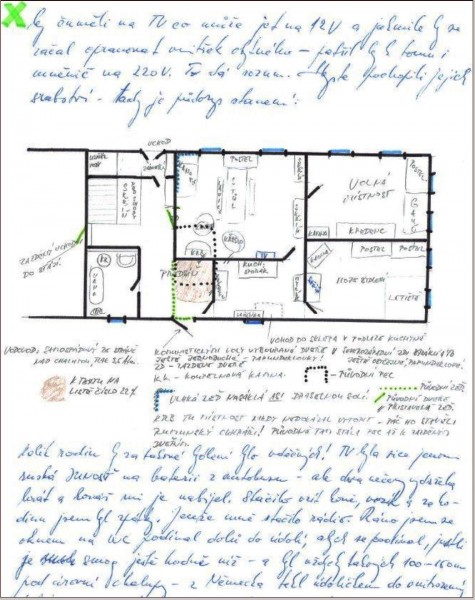
ANNEX TO ARTICLE 3
- OFFICIAL DOCUMENTARY FILM -
- in Czech, with English subtitles
- English subtitles can be enabled in the video settings in the bottom bar


